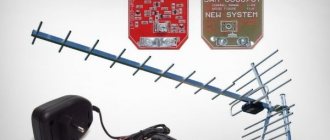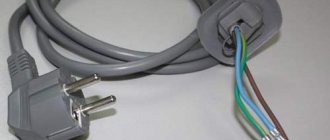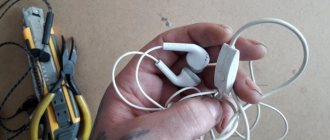Almost every family has a TV at home. Models may differ from one another, but the task of the item remains the same - to carry an informational and entertainment load. Every year the functionality of the TV improves. Therefore, those models that were common 10 years ago are outdated today.
Ultra-thin panels with large screens are sold. Modern Smart TV technologies are not much like old TVs. The only thing that remains common is that both in the past and now, models break down. The most common breakdown is when there is no picture on the TV, but there is sound.
LCD TV screen is black, but there is sound: Possible breakdowns and solution to the problem.
Good afternoon, dear readers of my blog! What to do if there is no picture, but there is sound?
Today I would like to talk about TV repair, or rather about fixing it in the case where there is sound, but the screen is black . What could be the cause or consequence of such a defect? How to fix it yourself? Is it difficult?
I will answer all these and other questions in my article! I hope you find it interesting and useful to read it. Let's get started!
First, look at your technique. If you purchased it very recently, then there is a high probability that the malfunction is the result of a defect or damage during assembly.
In this case, it is recommended to find the warranty certificate and go to the store where the TV was purchased. You are obligated to have it repaired, replaced or refunded. Don't be afraid to defend your rights!
If the TV has served you faithfully for several years, then you won’t be able to attribute the breakdown to a defect. Most likely, the backlight or battery has failed.
In this case, you need to make repairs, because you are unlikely to be surprised by a TV that functions as a radio. That's what I'm talking about. Look for tools and get mentally ready for repairs. I'll tell you what needs to be done if, when you turn on the TV, there is sound, but the screen does not show .
Setting up TV after fixing
Everything will depend on the processes that were done to fix the problem with the TV. Here is a list of some of them:
- If the decoder is replaced. There is no need to change anything. When replacing a faulty decoder with a TV tuner, you need to switch the source output for viewing channels and conduct an automatic channel search.
- If the backlight has been changed or the matrix has been replaced, check the brightness and contrast settings. They may need to be adjusted.
- If the set-top box has been replaced or repaired and reset to factory settings, you need to search for channels again. Auto search is the best option. Manual search takes longer, but will allow you to sort the found channels more thoroughly. All settings are made in the section: “Menu” – “Channels” – “Auto tuning”.
If you replace the cable or ports, you do not need to make any adjustments on the TV.
First check
Be sure to check the following elements of your TV first:
- Antenna cord;
- Distribution panel;
- Antenna located outside the apartment.
These places are most vulnerable to this type of breakdown, so checking them is mandatory. Pay special attention to the cable. It is pictured below.
Check it for fractures and cracks. It happens that it breaks due to a constant bent position. It is clear that such a cable will not be suitable for work.
If you find such a breakdown, then feel free to throw away the cable and run for a new one. There is 80 percent that the signal will return to normal after such a procedure, and the TV screen will no longer go dark.
If there are no visible violations of its integrity, then perform the following procedure:
- Pull the cable out, blow on it (this may blow dust out of it), and insert it back. Check the result. Over time, the cable may not work properly due to accumulated dust, so this method may help;
- If this does not correct the situation, then try connecting a different antenna cable to the TV. The old one may lose power over time and cannot cope with the load;
- Next, all that remains is to check the antenna, but doing this yourself is not recommended. It is better to call the technician responsible for servicing your antenna. He will probably do the repairs better than you.
System part
When the image on the TV has disappeared, but you were able to determine that the backlit screen is fully operational, but the TV channels are not showing, look for a problem in the cable connections (replace them), in the performance of the decoder, and in the correctness of the channel settings.
Video signal failure
When an LGi TV is paired with a TV tuner, wires are often used to receive sound and picture, which transmit sound and video separately. If the screen is black but there is sound, check the component and composite wires:
- RCA (tulips) - they are often implemented to connect digital receivers to TVs that are designed to receive only an analog signal. Check yellow, red or both plugs. They are responsible for the picture. They may be loose, damaged, or plugged into damaged connectors.
- VGA/ HDMI are component cables that have a single plug with multiple PINs. When one of the wiring inside is damaged, the video simply does not work. It is recommended to replace the cable or use a different type of cable (if feasible).
If you doubt that the cable is damaged, check its operation on other equipment.
Decoder problems
There may be a malfunction not only in the transmission of the TV signal via cable, but also in the problematic operation of the decoder. It can be installed:
- On a TV - if the signal goes to the TV via cable directly.
- In the receiver - when receiving a signal through an antenna cable and outputting the picture to TV through component and composite wires.
Repairing or flashing a decoder is not a simple procedure and requires disassembling the equipment, replacing or connecting a programmer for flashing. If the price of the firmware is justified, then replacing the decoder is almost equivalent to the price of a new receiver. If the decoder breaks on the TV, then it is recommended to replace the decoder, not the TV.
Why else can sound work, but there is no picture?
New TVs may have a screen-free feature. Roughly speaking, if you like to listen to TV in the background, but can’t watch it because you’re busy, then it will just help.
You may have turned it on accidentally, which is why there is no image. Click the buttons on the remote control, especially try “MENU”.
If the image appears in the settings, then it’s probably in this mode! By the way, most often it is installed on the following brands of TVs:
- Philips;
- Sony;
- LG;
- Samsung;
- Toshiba.
If this does not help to return the image, then the problem is at the hardware level. Let's take a deeper look at the problem!
Reasons for missing image
The causes of the problem are mainly hardware in nature. Software malfunctions are less common.
The most common type of malfunction is a black screen with sound. There may be no sound, but the TV appears to be on. The cause of this problem is non-working backlight diodes.
Users may experience breakdowns both immediately after purchasing the TV (manufacturer’s defect) and during operation (as a result of wear and tear on hardware components).
The inverter that supplies power to the diodes may also be broken.
Fig.3
Owners of LCD TVs are often faced with a situation where a split into two parts appears on the screen.
The contrast levels of the sides differ from each other, and many “dead” pixels appear. The reason is a faulty matrix.
In rare cases, the problem disappears after rebooting the device. In the rest, you will have to replace the matrix.
Fig. 4 – Problems with the matrix
If the backlight on the TV does not work, it is easier to immediately take it for repair or return it to the store if you just bought the device.
This is a common factory defect caused by a faulty motherboard.
This problem is characterized by the appearance of a short flash after turning on the TV and a black screen.
If you get very close to the TV and try to look closely with a flashlight, you can see the picture.
The sound works fine, but it is impossible to watch such TV. In the video you can see what the problem looks like:
At home, an ordinary user is unlikely to be able to replace the board, so it is better to immediately take the device to a service center.
Note that in smart TVs, the cost of repairing the board can sometimes be equal to the price of a new TV.
Another common problem is the appearance of frame scanning. The image is divided into two equal chats, one of which is completely distorted, and the second is characterized by very poor quality. The problem is accompanied by sound interference.
The cause of the breakdown, as in the previous version, is the system board. The problem cannot be fixed using standard methods.
Fig.5 – example of frame scan
Also, the absence of a picture can be the cause of a one-time bug, problems in the functionality of the video tuner, radio channel, video processor, color block and other components.
Let's figure out how to determine the nature of your TV's breakdown and what to do for effective repairs.
Checking the LEDs of an LCD TV
Often the TV does not produce an image due to failed LEDs or lamps (this depends on the TV).
You can check them in a fairly simple way. Bring some light source to the TV screen. If the image is even slightly visible, then the problem is precisely the failure of the LED strips. Of course, there are options for breakdowns of other parts of the TV, but this is the most common.
Surely, if you are reading this article, then you are not a TV repairman. In this case, I sincerely do not recommend trying to replace or repair LED strips yourself.
Only a professional in this field can do this efficiently. It’s better to contact a specialist, because in this way you will guarantee yourself high-quality equipment repairs.
You should know it:
How and with what to wipe the TV screen from dust and stains at home?
How to remove dead pixels from a monitor or TV at home?
We fix the problem ourselves
Before carrying out any repair work, you should conditionally divide all your actions into three stages:
- Determine the nature of the failure using the guide described below;
- Run diagnostics. This includes finding a broken hardware component or finding the cause of a software bug;
- Repair. If you have basic microprocessor repair skills, fixing a broken component should be fairly easy. In any case, on YouTube you can find a lot of instructions for repairing any TV model. For those who do not want to start repairs themselves, we recommend contacting a service center. However, it is better to independently determine the nature of the breakdown in advance. This will protect you from possible overpayment at the service center.
Follow the steps below to fix the missing picture problem on TV.
The long-term life of your TV is entirely up to you!
In most cases, equipment fails due to improper use. Do not forget that the TV also has certain rules of use, which simply cannot be violated, otherwise breakdowns will not be such a rare occurrence.
The inverter is the most vulnerable and expensive part of the TV. Even craftsmen who undertake TV repairs most often simply fix it, because buying a new one is simply expensive.
This part fails most often on LG and Samsung . And this happens due to continuous or improper use of the TV. Remember these rules:
- Everyone needs rest, even household appliances. Continuous operation only leads to rapid wear of spare parts, and, consequently, to breakdowns in the system;
- Regular cleaning of the TV is the key to long-term viewing of films and TV series. Dust and dirt can negatively affect the operation of equipment, even causing a short circuit. This way you can burn all the wiring! Be careful and wipe your TV often;
- Moisture is contraindicated for electrical appliances. Do not flood your TV with water or other liquid, as this can simply burn it;
Remember that the service life of your equipment depends only on you!
Inverter problems
The inverter on a SAMSUNG TV may burn out. It is responsible for supplying voltage to the backlight lamps, adjusting the image level and brightness, protecting microcircuits and boards from overloads and short circuits.
If the inverter is faulty, the display will stop displaying light. This means that instead of a video image, the TV will display a regular black screen.
To determine if the inverter is broken, you need to conduct a visual inspection of the main components of the TV, which are located on the circuit board under the back cover. To check this component you will need a multimeter - a special device for measuring various electrical quantities.
The inverter can burn out transformers, lamps or controllers located on the lamps. The burnt part must be replaced with a new one. In some cases, you can repair the inverter - you will need a soldering iron for this.
What problems can you fix yourself?
Useful recommendations from professionals in case the TV screen turns off but there is sound:
- Check the integrity of the connecting cable. If the wire is broken or damaged, replace it with a new one.
- Increase the volume to maximum, after which the black screen may disappear and the TV will start working as usual.
3. On the rear panel, check the quality of the connection of the antenna cable to the corresponding socket. The plug may be damaged.
4. Check your TV settings; it is possible that the image disappears due to incorrectly set parameters. Return to default settings.
The recommendations presented above are only relevant if the screen is in working condition. How can I check this? Turn on the TV, if immediately after startup the screen saver appears and then disappears, then the problem lies in incorrect settings or connection (in this case, a lot depends on the signal source). Users can resolve these types of problems on their own.
Blue screen, white screen and all sorts of other faults can also occur due to faulty hardware modules that burn out due to short circuits. To prevent such breakdowns, get an uninterruptible power supply.
If, after turning on the Smart TV, the picture disappears and the sound disappears, then first of all you need to check the functionality of the wire. This can be done using the Moninfo program. The software is designed to check the quality of transmission of various signals (audio, video).
If the software detects irregularities, then the problem lies in the connecting cable. To check the quality of the video signal, follow the simple step-by-step instructions:
- On the remote control, press the button with the house icon.
- Go to the settings menu.
- Select the “Support” section, and then the “Self-diagnosis” tab.
- Activate the “Run Image Test” command.
- After the diagnostics are completed, a list of recommendations from Samsung will appear, use them.
Let's also consider other problems and analyze ways to eliminate them.
| Defect | Troubleshooting |
| The image is flickering or the brightness has decreased. | Deactivate the "Energy Saving" command or turn off the "Eco" mode. |
| TV diagnostics revealed no problems. | Check if the cable is connected correctly. |
| The image displayed on the screen is too dim. | Adjust brightness in the Advanced Settings menu. |
| The picture is divided into two parts, blurry and shaking. | Use the Auto Motion Plus feature. |
| The TV turns off randomly. | Disable all additional functions that are aimed at saving energy. |
| The image is distorted and there is noise. | Check the signal reception quality; the cable or antenna may be damaged. |
| Incorrect color rendering. | Disconnect the antenna cable and then connect it again. |
| Violations in the color balance of the screen. | Revert to default settings. |
| A dotted line appears along the edges of the display. | Change the resolution, switch to 16:9 aspect ratio. |
Almost all types of problems can be fixed on your own at home. Without the use of professional equipment. It is much more difficult with hardware failures, since in order to replace a broken part, you need to disassemble the TV.
Possible problems
The most common reason why LG does not display TV channels is a malfunction of hardware components:
- power supply or backlight;
- inverter;
- matrix and capacitor, etc.
Lack of contact in cable connections
If the sound comes out on an LG TV at a normal volume level, but the screen does not light up at all, one of the diagnostic measures will be to check the cables through which the image is transmitted:
- antenna;
- HDMI ;
- from your cable TV provider;
- Internet cable (if you use a set-top box).
To check the cables you will need a utility called Moninfo. It is needed to find some problems in the transmission of sound signals and those responsible for the picture. If the application detects a failure, you should carefully check the cable pins for damage.
Make sure that the TV is connected to an electrical outlet that has voltage. Check that the cable is correctly connected to the connector and that there are no kinks or damage. If the cable is damaged, replace it.
If the electrical connector becomes loose, replace it as soon as possible. Damage to cable insulation is extremely dangerous and can lead to short-circuiting of equipment contacts. The user may also be injured.
Power supply failure
If the sound is reproduced normally on your LG TV, but there is no image at all, or the picture has become dark, constantly jerks, is displayed incorrectly, or there is a delay in playback, a failure in the power supply is to blame.
It is absolutely not recommended to try to fix something yourself without experience and knowledge in the field of electronics. You can only make it worse, and then there will be nothing left but to buy a new TV. It’s better to call a professional who can quickly diagnose the problem and fix it.
However, it is quite acceptable to conduct an initial check for problems yourself:
- Discharge the capacitors.
Turn off the TV's power (unplug from the socket). Remove the back cover, check if the cable is twisted or broken, and if the buttons and fuse are working. - Inspect the capacitor and resistor.
Make sure they don't swell or melt. If such a problem is discovered, the damaged parts need to be replaced - this is the work of specialists. - Measure the voltage of the output power circuit.
These values must be the same as the numbers indicated in the documents for the TV or written on the board. If the voltage is different and reaches a value of about 200 V, the cause of the malfunction should be sought in the primary circuit. - Lightly tap the TV.
If the TV responds to tapping - the image flickers, changes color, or becomes normal for a few seconds, the root cause of the problem is poor soldering of the module or wire. Specialized repairs are required.
Perform these steps one by one.
Problems with the video processor
This failure can manifest itself either immediately or gradually. If the problem is in the video processor, color distortion or incorrect display of shadows appears, one of the colors may disappear, the image may have a blue tint. The audio track may be ahead of the picture.
In the event of this malfunction, all that remains is to replace the processor with a new one.
Screen backlight unit/burnt out diodes
One of the most common reasons for image loss is a malfunction of the screen backlight. This problem is easy to identify: if the image flickers and jerks, this is exactly the case described.
How to identify the problem if nothing is visible on the screen:
- Take a regular flashlight or use the one built into your phone.
- Start flashing the image on the TV. If it's a backlight issue, you'll be able to see the picture from a certain angle.
In case of breakdown, it is better to send the device to a service center. Due to the lack of necessary spare parts, it is almost impossible to repair the fault yourself. You need to order them from official sellers, and this is expensive and time-consuming. You won't find such spare parts on the radio market.
If you still find the opportunity to replace the LEDs yourself, follow these steps:
1. Place the TV on a table or other flat, stable surface with the screen facing down.
2. Unscrew the screws on the back cover and remove it.
3. Disconnect the board cables, loosen the screws securing them, and remove the boards from the TV. Then remove the mounting bolts from the bottom strip and set it aside.
4. Unscrew the remaining screws on the periphery, turn the TV over with the screen facing up, and then begin to disassemble the protective frame, and then the monitor itself.
5. Remove the frame and the LED panel from the latches. They are easy to remove: lift both sides and twist inside. If you have a different type of latches, lift the edge of the latches and slide everything to the right. Now you have an LED panel in front of you.
6. Simply replace the LED strips that open in front of you with new ones and put the TV back together.
Video instruction:
Matrix, matrix cable
The main symptoms of problems in displaying images on LG due to the matrix:
- the image periodically disappears and appears, or is shown only on one half of the screen;
- no LG logo when turned on;
- ripples and interference appear (the video “shakes”);
- distortion appears: the screen begins to “strip” or duplicate the picture in any geometric order.
The matrix may stop working normally due to a short circuit, voltage surges, moisture or mechanical damage. A faulty matrix cannot be repaired. Therefore the part is replaced.
With this problem, you need to definitely contact the service center, where they will tell you for sure whether the problem is in the matrix itself or in its cable. You should not carry out repair work yourself.
Before attributing the problem to a matrix failure, it is necessary to check the performance of the inverter.
Inverter failure
There are a lot of malfunctions that can be associated with a voltage inverter. And it is simply impossible to describe them all.
The problem is if:
- the picture flickers and there are distortions;
- the image appears with a delay or does not appear at all;
- the TB display dims and goes dark almost immediately after switching on;
- the sound is ok, but the picture is blurry;
- the picture looks blurry or too dark, not bright (so that it is impossible to see anything).
The main function of the inverter is to power the backlight lamps. Therefore, if the TV screen does not light up, the cause may be a malfunction of this element.
In addition to transmitting voltage to the backlight, the inverter also performs other tasks:
- converts direct current into alternating current;
- stabilizes the input current;
- regulates image brightness and protects the board from the risk of short circuit.
Therefore, if any part fails, it must be replaced immediately, otherwise it may cause other, more serious problems. The problem can be in any part of the element: in lamps, electrical transformers, “keys” or controllers on the board.
The malfunction will be revealed during the inspection. An inverter can be repaired by a person who knows how to operate a soldering iron, a multimeter, and who has at least basic knowledge of physics and electrical engineering.
Swollen or burnt capacitors
The capacitor problem is caused by power surges. Malfunctions appear like this:
- after turning on the power or after a short time, the display goes out and the TV turns off spontaneously;
- the image is double or completely absent;
- Colors are not reproduced correctly, brightness disappears - the picture becomes darker.
Having disassembled the device, you will find on the board that the capacitor has swollen or even exploded. Often the situation is accompanied by a blown fuse. You shouldn't try to do something yourself. Take the TV to a service center.
This is as serious as a matrix failure. If the malfunction is not corrected in time, this will have a detrimental effect on the operation of the power supply.
Other Possible Causes
The problem may also be with the decoder. It is installed:
- on a TV - when the signal is transmitted directly to the TV via cable;
- in the receiver - when the signal is received via an antenna cable and the picture is output to the TV through other types of wires.
If this element is damaged, wide stripes will appear on the TV screen. This can happen due to dysfunction of the loop contacts.
Repairing or upgrading a decoder is not an easy process. You will need to disassemble the equipment, replace or connect a programmer for updating.
If you need to replace the decoder in the receiver, it is better to buy a new receiver. The price will not differ much. If the decoder on the TV is damaged, replace the decoder in the TV.
When sound is output separately
When connecting a home theater or laptop, a video signal is often output to an LG or Samsung TV, and the sound comes from the speakers.
In such a situation, there may be more reasons for the lack of an image:
- The wire is faulty. Moreover, we are not talking about partial damage, but a complete malfunction. You need to replace it and the problem will be solved.
- Invalid TV channel. You need to switch to the one that outputs the signal from the connector used to connect the equipment.
It will be most difficult if several devices are connected to the TV, because... the problem of the lack of an image may not be in the image itself, but in the device reproducing the content.
The best way to check and find a faulty device is through a wireless connection. In this case, it will immediately become clear whether the problem is with the TV or the same home theater.
How to conduct general TV diagnostics
First of all, you need to enter the TV receiver menu, turn up the brightness, check the contrast settings. You must make sure that the display parameters are set correctly, in accordance with the operating instructions for the device. Next, you need to disable power saving if it is enabled. Also exit night mode if your device supports it.
In addition, before checking the TV itself, you need to make sure that the external connections are reliable. If possible, replace the HDMI cable. Check that the source of the TV signal - digital terrestrial television set-top box, satellite TV - is functioning properly.
If there are several TV receivers in the house, you can check the operation of all peripherals by replacing the TV with a known good one . If everything is in order, you need to diagnose the device itself. To do this, it is advisable to have some skills in radio electronics or entrust the work to a master.
Prevention for stable operation of the TV
Any digital device requires care and careful use to extend its service life.
For modern TVs, which have become more like computers (they have their own operating system), there are also some tips to keep them “living”.
- Most of all, any electrical appliance is “afraid” of voltage surges. Use UPS, stabilizers;
- You cannot leave the TV on for a long time. This applies to those who like to use it as a radio. Or fall asleep listening to the series, leaving to work until the morning;
- Make sure that the TV is not subjected to physical impacts (impacts, sharp shocks). There should not be any liquids nearby - water, tea, coffee, etc.
With careful use of any TV, you can significantly increase the time it is used. It is convenient to adhere to the last point if you mount the TV on the wall.











